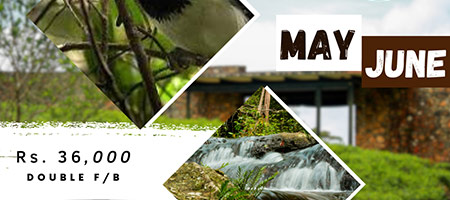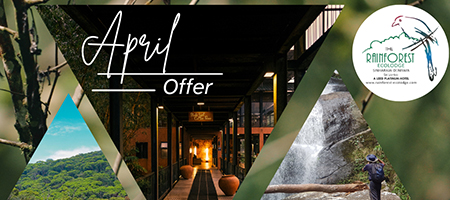Why are rainforest always hot and humid?
Tropical rainforests are warm, wet forests with many tall trees. In most tropical rainforests, it rains every day. Tropical rainforests grow in a narrow zone near the equator. They are found in Africa, Asia, Australia, and South and Central America. The part of the rainforest that the ecolodge is found is an exception to this rule due to its 1000 meter altitude.
What are rainmakers?
Rainforests need lots of water and most of it comes pouring down as rain – at least 200 cm per year. Some tropical rainforests get more than 3 cm per day! When it is not raining, the leaves are dripping and steam is rising. This keeps the whole rainforest constantly wet and steam. Rainforest trees are always “sweating” water. One tree might release over 755 L of water every year. This makes rainforest climates very different from other environments. In other climates, the water vapour blows away and later falls as rain in far off areas. But in rainforests half the precipitation comes from the forests’ own evaporation. Much of the rain that falls on the rainforest never reaches the ground. It stays on the trees because the leaves act as urn.
Why is there so much Bio diversity?
Although they cover a small area – less than 2% of Earth’s surface – rainforests are home to about half the life on Earth. In fact, tropical rainforests support the greatest biodiversity on Earth.
Canopy: The spreading structure of the rainforest canopy means there are more places for plants to grow and animals to live. The canopy offers many unique sources of food and shelter. For example, there are plants in the canopy called bromeliads that store water in their leaves. Frogs use these pockets of water like ponds for hunting and laying their eggs. Since all their needs are met in the canopy, some frog species spend all their lives there.
Climate: Tropical rainforests receive almost 12 hours of sunlight every day. This sunlight is converted to energy by plants through the process of photosynthesis. Since there is a lot of sunlight, there is a lot of energy locked up in the rainforest. This energy is stored in plants that are eaten by animals. Because there is a lot of food, there are many species of plants and animals.
How do we protect the rainforest?
The Conservation of tropical rainforests should be easy. They have survived for millions of years. The trick to keeping them healthy is to not take too much too fast. This gives the rainforests time to recover from human activities like logging. But many countries that have tropical rainforests are poor. They can make money by cutting down and developing the rainforests. But uncontrolled development results in deforestation, erosion, and loss of biodiversity.
Why are rainforests beneficial to everyone?
Tropical rainforests are important to everyone, not just to the plants and animals living there. For example, scientists are always discovering new plants. Some of these plants contain substances that can be made into medicines. In addition, tropical rainforests store huge quantities of carbon, while producing much of the world’s oxygen. Some people call tropical rainforests the lungs of the planet because they make so much of the oxygen that animals breathe. Another important role tropical rainforests play is in regulating global weather. They maintain regular rainfall. They also help prevent floods, droughts, and erosion.







